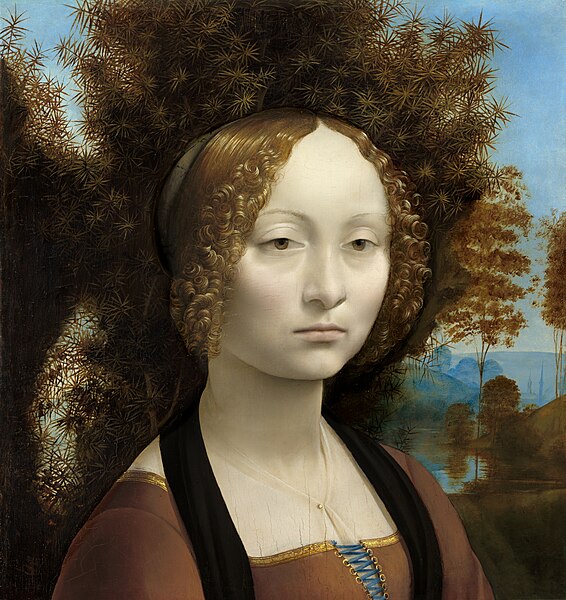
Title: Ginevra de’ Benci
Artist: Leonardo da Vinci
Date Painted: c. 1474-1478
Medium: Oil on Panel
Period: Renaissance
Dimensions: 38cm x 37cm
Location: National Gallery of Art, Washington
Summary of Ginevra de’ Benci
Ginevra de’ Benci is a portrait painted by Leonardo da Vinci around 1474–1478. This artwork is significant as it is one of the few female portraits Leonardo completed, alongside being one of his early masterpieces that showcases his developing style and technique.
Subject and Historical Context
The painting depicts Ginevra de’ Benci, a young woman from a wealthy family in Florence. She was renowned for her intelligence, beauty, and poetry skills. The painting is believed to have been commissioned to commemorate her marriage to Luigi di Bernardo Niccolini at the age of 16. The portrait is a testament to Ginevra’s character, reflecting her intellectual depth and personal virtues.
Artistic Elements and Techniques
- Technique and Composition: Leonardo’s use of sfumato, a technique that blends colors and tones seamlessly, is evident in Ginevra’s delicately modeled face, creating a lifelike presence that was revolutionary for its time. The portrait is noted for its detailed depiction and subtle color palette, capturing the serene and introspective nature of its subject.
- Background and Symbolism: Unlike the typical portraits of the era, Ginevra is depicted against a natural backdrop, a juniper bush, which is a play on her name (Ginevra sounds like “ginepro,” Italian for juniper) and symbolizes chastity and protection. This choice reflects Leonardo’s interest in nature and his innovative approach to portraiture.
- Reverse Side: Unique among Leonardo’s portraits, the reverse side of the panel features a wreath of laurel, palm, and juniper surrounding a scroll with the motto “Virtutem Forma Decorat” (Beauty adorns virtue). This emblem and motto reinforce the portrayal of Ginevra’s character, emphasizing her virtuous nature.
Provenance and Current Location
The painting’s history after its creation is somewhat obscure until it resurfaced in the 19th century. It was acquired by the Prince of Liechtenstein and remained in the Liechtenstein Collection until it was purchased by the National Gallery of Art in Washington, D.C., in 1967, where it currently resides. It is the only painting by Leonardo in the Americas.
Legacy and Analysis
Ginevra de’ Benci is celebrated for its innovation in portraiture, moving beyond the traditional profile view prevalent during the Renaissance to a more personal and engaging three-quarter pose. The painting’s psychological depth, the subtlety of its composition, and its refined execution exemplify Leonardo’s genius and his contributions to the art of portraiture. It remains a subject of ongoing study and admiration, reflecting Leonardo’s deep interest in the individual personality and his mastery of painting techniques.